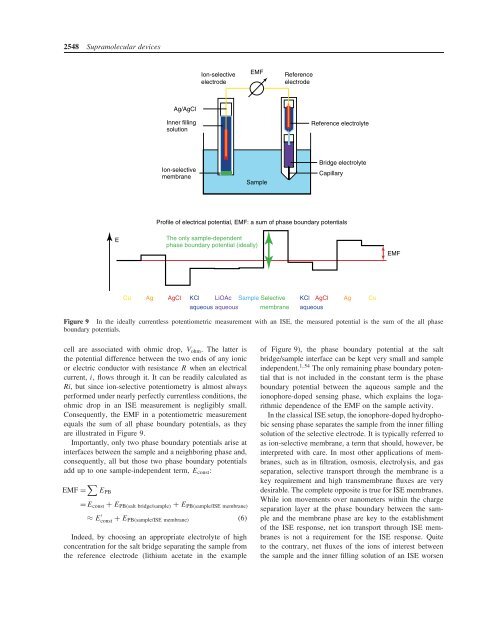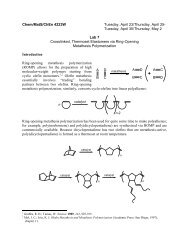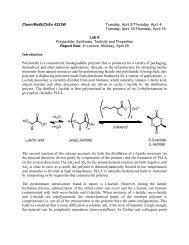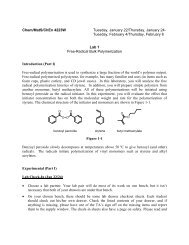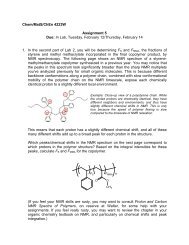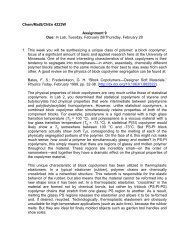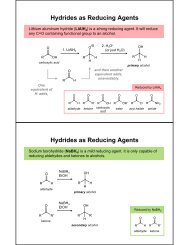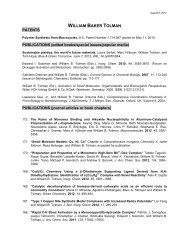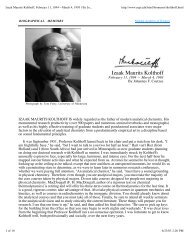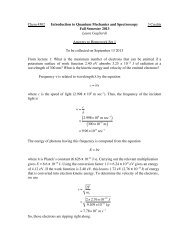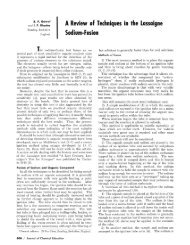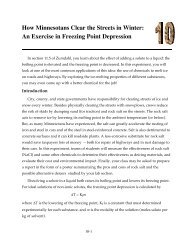Ion-Selective Electrodes With Ionophore-Doped Sensing Membranes
Ion-Selective Electrodes With Ionophore-Doped Sensing Membranes
Ion-Selective Electrodes With Ionophore-Doped Sensing Membranes
You also want an ePaper? Increase the reach of your titles
YUMPU automatically turns print PDFs into web optimized ePapers that Google loves.
2548 Supramolecular devices<br />
<strong>Ion</strong>-selective<br />
electrode<br />
EMF<br />
Reference<br />
electrode<br />
Ag/AgCl<br />
Inner filling<br />
solution<br />
Reference electrolyte<br />
<strong>Ion</strong>-selective<br />
membrane<br />
Sample<br />
Bridge electrolyte<br />
Capillary<br />
E<br />
Profile of electrical potential, EMF: a sum of phase boundary potentials<br />
The only sample-dependent<br />
phase boundary potential (ideally)<br />
EMF<br />
Cu Ag AgCl KCl LiOAc Sample <strong>Selective</strong><br />
aqueous aqueous membrane<br />
KCl AgCl Ag Cu<br />
aqueous<br />
Figure 9 In the ideally currentless potentiometric measurement with an ISE, the measured potential is the sum of the all phase<br />
boundary potentials.<br />
cell are associated with ohmic drop, V ohm . The latter is<br />
the potential difference between the two ends of any ionic<br />
or electric conductor with resistance R when an electrical<br />
current, i, flows through it. It can be readily calculated as<br />
Ri, but since ion-selective potentiometry is almost always<br />
performed under nearly perfectly currentless conditions, the<br />
ohmic drop in an ISE measurement is negligibly small.<br />
Consequently, the EMF in a potentiometric measurement<br />
equals the sum of all phase boundary potentials, as they<br />
are illustrated in Figure 9.<br />
Importantly, only two phase boundary potentials arise at<br />
interfaces between the sample and a neighboring phase and,<br />
consequently, all but those two phase boundary potentials<br />
add up to one sample-independent term, E const :<br />
EMF = ∑ E PB<br />
=E const + E PB(salt bridge/sample) + E PB(sample/ISE membrane)<br />
≈ E ′ const + E PB(sample/ISE membrane) (6)<br />
Indeed, by choosing an appropriate electrolyte of high<br />
concentration for the salt bridge separating the sample from<br />
the reference electrode (lithium acetate in the example<br />
of Figure 9), the phase boundary potential at the salt<br />
bridge/sample interface can be kept very small and sample<br />
independent. 1, 54 The only remaining phase boundary potential<br />
that is not included in the constant term is the phase<br />
boundary potential between the aqueous sample and the<br />
ionophore-doped sensing phase, which explains the logarithmic<br />
dependence of the EMF on the sample activity.<br />
In the classical ISE setup, the ionophore-doped hydrophobic<br />
sensing phase separates the sample from the inner filling<br />
solution of the selective electrode. It is typically referred to<br />
as ion-selective membrane, a term that should, however, be<br />
interpreted with care. In most other applications of membranes,<br />
such as in filtration, osmosis, electrolysis, and gas<br />
separation, selective transport through the membrane is a<br />
key requirement and high transmembrane fluxes are very<br />
desirable. The complete opposite is true for ISE membranes.<br />
While ion movements over nanometers within the charge<br />
separation layer at the phase boundary between the sample<br />
and the membrane phase are key to the establishment<br />
of the ISE response, net ion transport through ISE membranes<br />
is not a requirement for the ISE response. Quite<br />
to the contrary, net fluxes of the ions of interest between<br />
the sample and the inner filling solution of an ISE worsen


